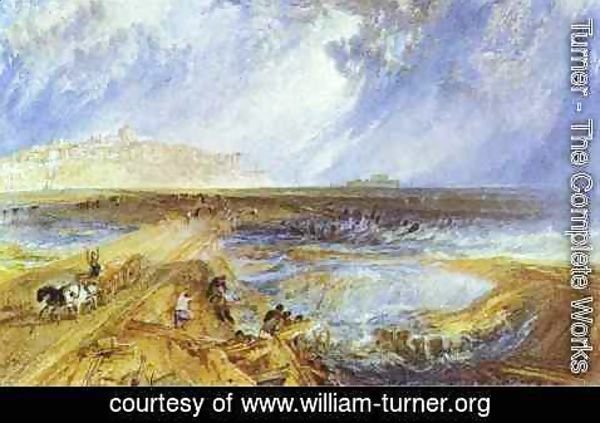A dramatic depiction of Robert Stevenson’s engineering marvel, the Bell Rock Lighthouse, by Britain’s most celebrated artist Joseph Mallord William Turner (1775-1851), will shine its light on the National Galleries of Scotland (NGS)’s seasonal exhibition Turner in January, which opens at the Scottish National Gallery on New Year’s Day. In 2019, this much-loved annual exhibition is supported by players of People’s Postcode Lottery for the seventh year.
In a tradition that stretches back more than a century, every January the National Galleries of Scotland (NGS) displays an outstanding collection of Turner’s radiant watercolours, bequeathed in 1900 by one of the greatest connoisseurs of his work, Henry Vaughan (1809-1899). Conscious that limited exposure would preserve the brilliant colour and exceptional condition of the works, Vaughan stipulated in his will that his Turners should only ever be shown during the first month of the year, when daylight in Edinburgh is at its weakest. The display runs throughout January, providing a thoughtful counterpoint to the more energetic celebrations of Hogmanay, and a welcome injection of light and colour during the darkest time of the year.
This year, another outstanding Turner watercolour from the NGS collection will also be on show.Bell Rock Lighthouse was commissioned 200 years ago by the lighthouse engineer Robert Stevenson (1772-1850) to illustrate his book, Account of the Building of Bell Rock Lighthouse. Bell Rock is the oldest surviving rock lighthouse in the British Isles and Stevenson’s engineering masterpiece. First lit in 1811 and constructed at a cost of £61,331 using revolutionary building methods, it stands on a partially submerged reef off the Angus coast, regarded by sailors as among the most dangerous places on the east coast of Scotland. Turner’s spectacular watercolour shows the lighthouse standing proudly above the pounding waves, an indomitable symbol of Stevenson’s great achievement.
The 38 watercolours that make up the Vaughan Bequest, encapsulate Turner’s entire career, and were carefully chosen for their outstanding quality. Highlights including subtle and meticulous images of the 1790s, such as

Rye, Sussex

and Lake Albano
and the spectacular Venetian views of 1840,

such as The Piazzetta, Venice

and Venice from the Laguna,
which capture the drama and explosive skies of late summer Adriatic storms.
Vaughan was just 21 when he inherited his fortune from his father, who had been a wealthy hat maker. During his lifetime Vaughan devoted himself to travel, collecting fine art and philanthropy and became known as a distinguished and generous collector, most notably for nineteenth-century British art, in particular Turner and Constable.
Born in London in 1775, Turner’s talent was evident from a remarkably young age – the gifted draughtsman was exhibiting works at the Royal Academy by the age of 15. He was a prolific, innovative and energetic artist who went on to exploit every possibility of the watercolour medium, travelling widely to capture stunning land- and seascapes. At first, Turner began his travels with sketching tours in England, Wales and Scotland, then later across Europe, where he gathered material for masterful watercolours and oil paintings.
Turner’s extraordinary command of watercolour technique is evident throughout the works in the bequest, from the delicacy and precision of his illustrations to the work of Sir Walter Scott (1771-1832), such as

Rhymer’s Glen, Abbotsford

and Loch Coruisk, Skye,
to the atmospheric light effects of his 1836 views of the Aosta valley in the Alps, including

Brenva Glacier from the slopes of Le Chetif above Courmayeur.
Christopher Baker, Director of European and Scottish Art and Portraiture at the National Galleries of Scotland said:
“Every January we are delighted to display Turner’s spectacular watercolours, donated with great generosity by the distinguished collector Henry Vaughan. This wonderful tradition has become the longest running single artist exhibition in the world. In 2019 it will be enriched with Turner’s splendid Bell Rock Lighthouse – an extraordinary depiction of Scotland’s seafaring past. Turner in January is the perfect antidote to the darkness of Edinburgh in winter.”
